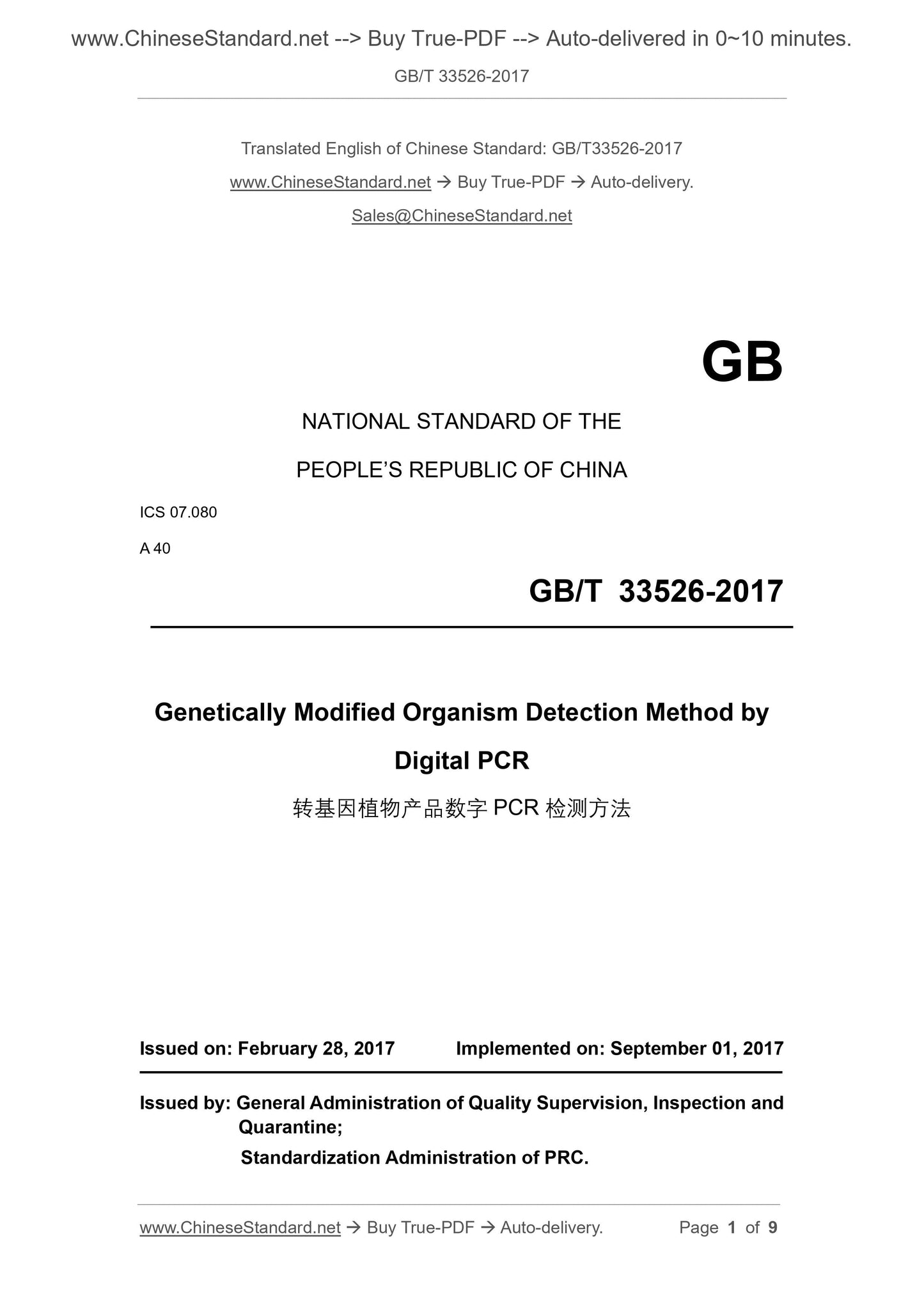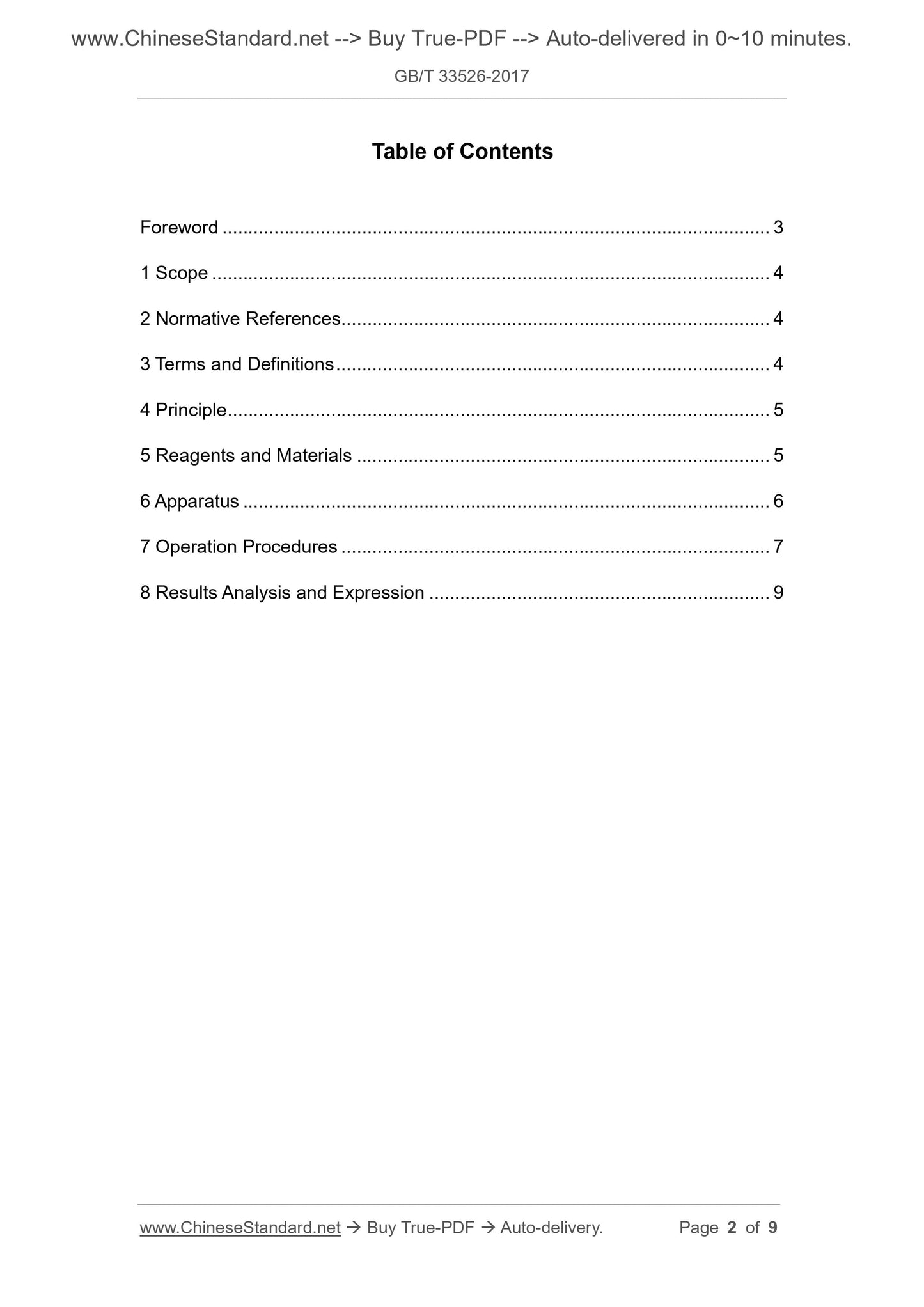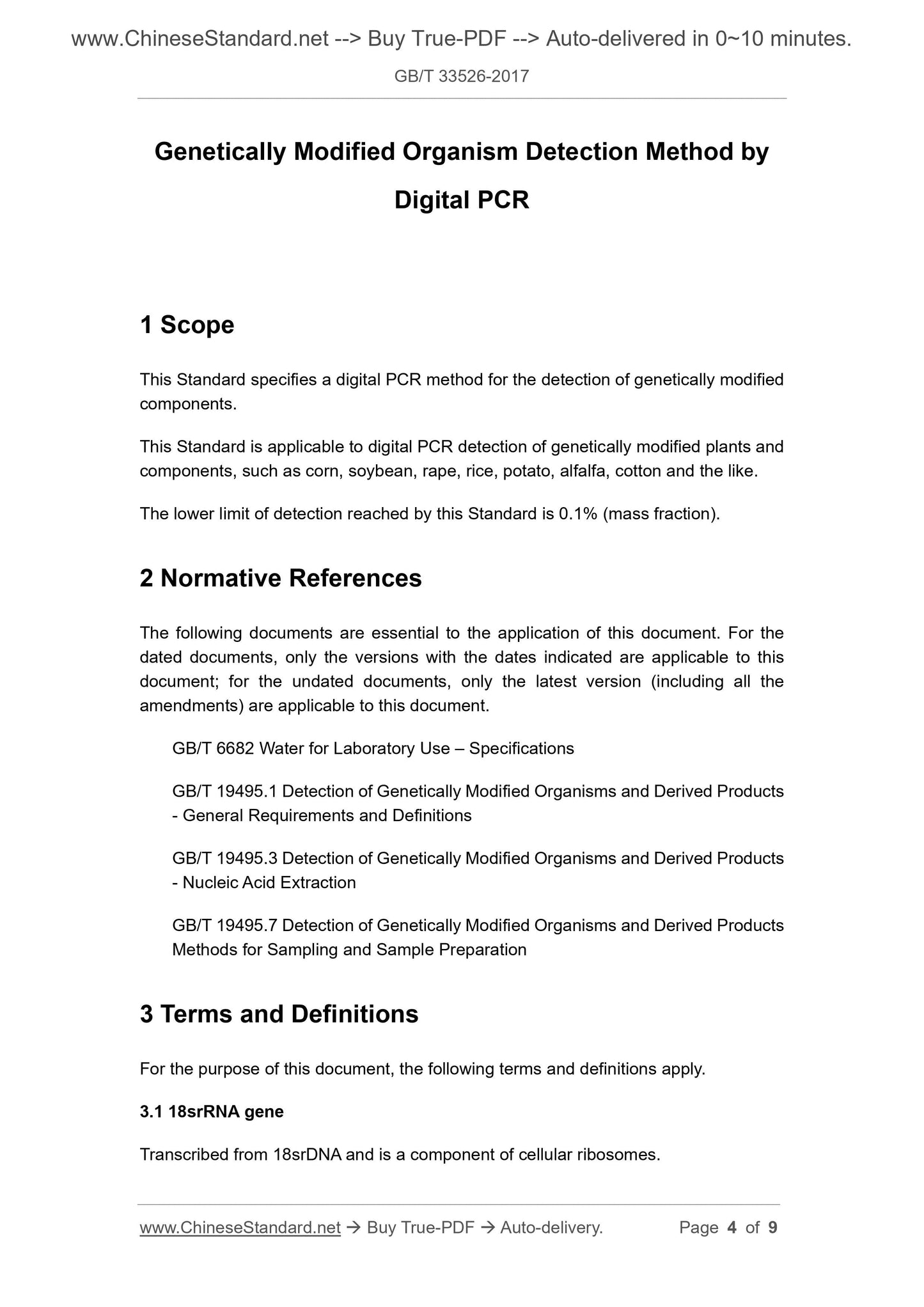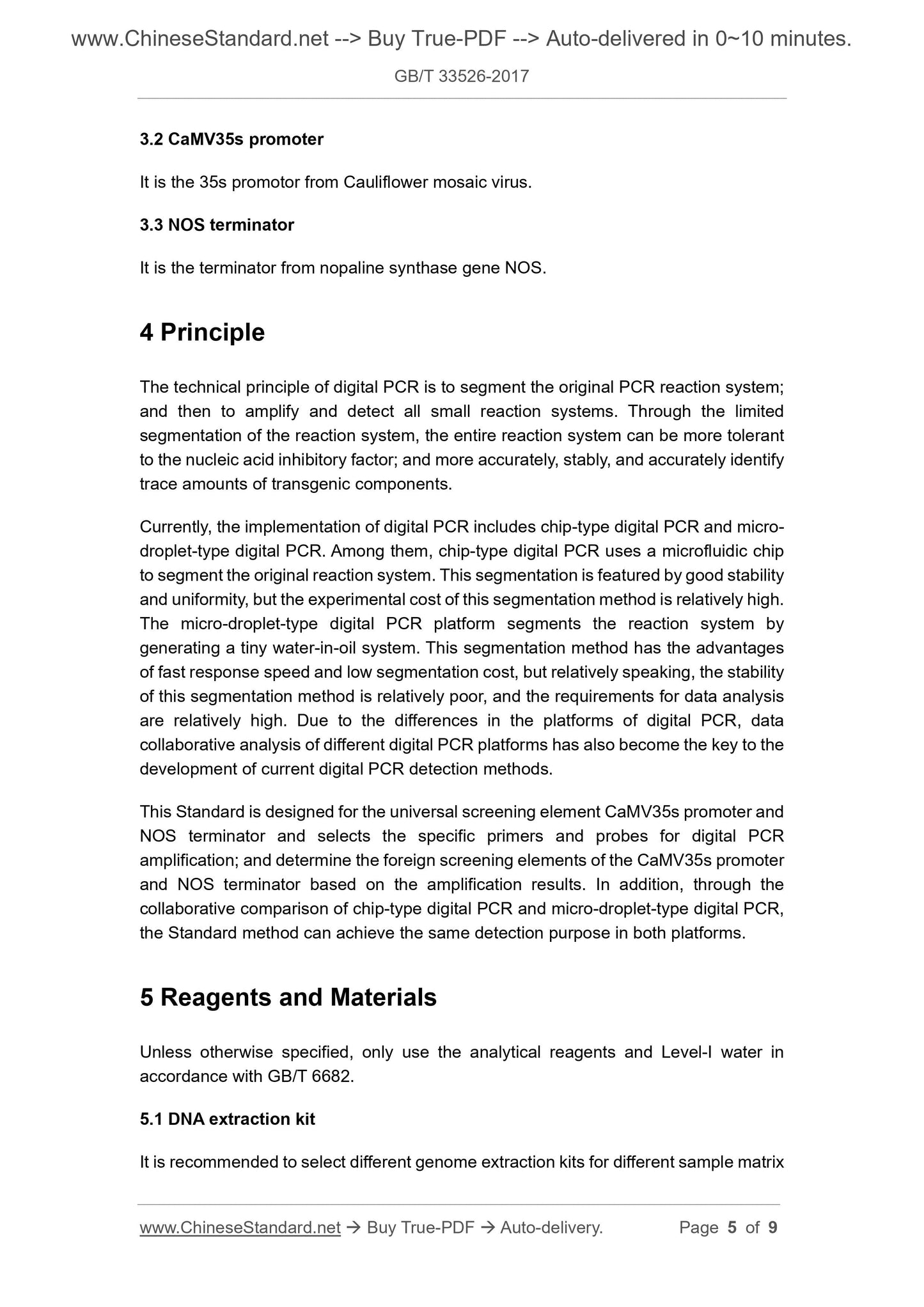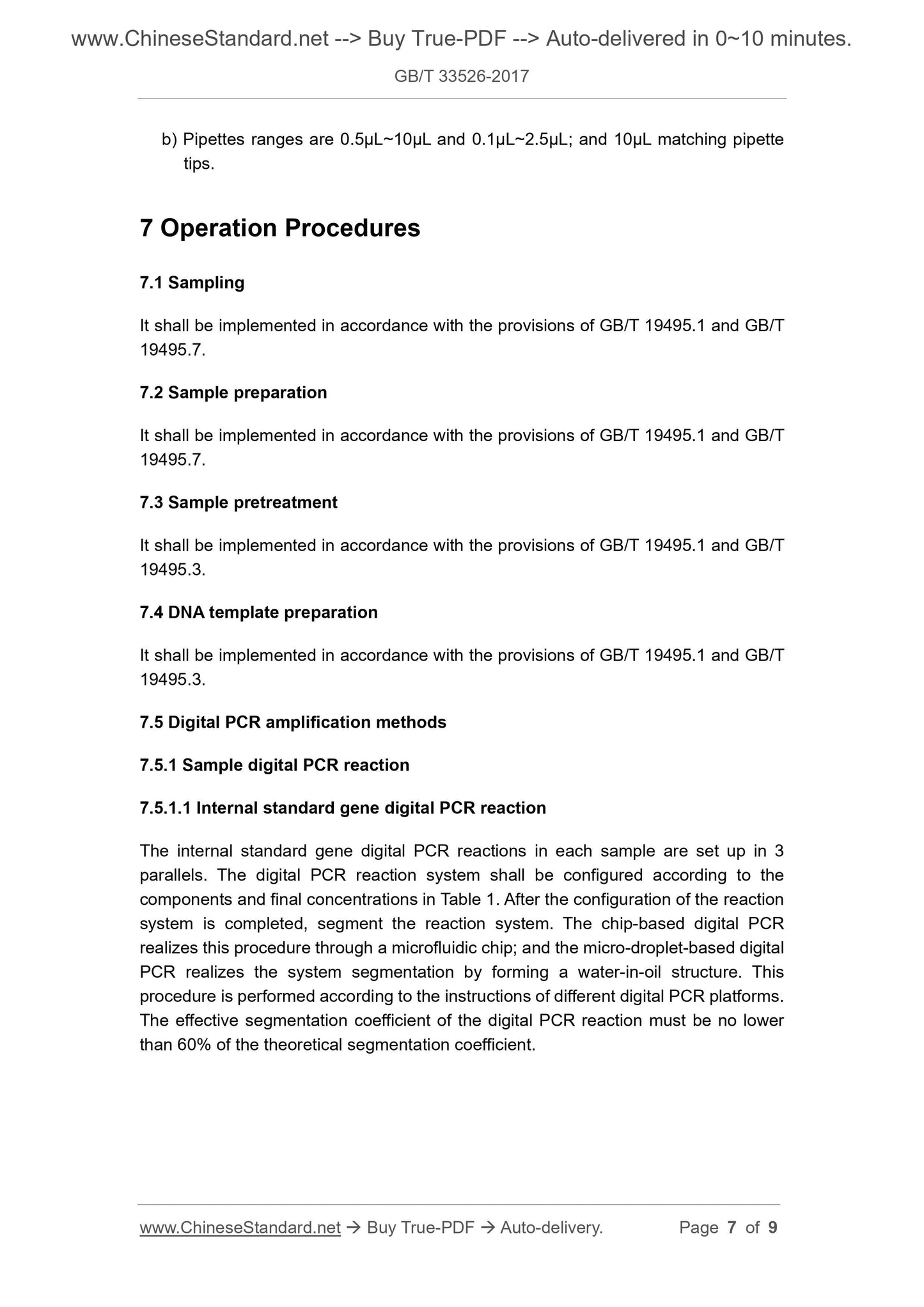1
/
of
5
PayPal, credit cards. Download editable-PDF & invoice In 1 second!
GB/T 33526-2017 English PDF (GBT33526-2017)
GB/T 33526-2017 English PDF (GBT33526-2017)
Regular price
$120.00 USD
Regular price
Sale price
$120.00 USD
Unit price
/
per
Shipping calculated at checkout.
Couldn't load pickup availability
Delivery: 3 seconds. Download true-PDF + Invoice.
Get QUOTATION in 1-minute: Click GB/T 33526-2017
Historical versions: GB/T 33526-2017
Preview True-PDF (Reload/Scroll if blank)
GB/T 33526-2017: Genetically modified organism detection method by digital PCR
GB/T 33526-2017
NATIONAL STANDARD OF THE
PEOPLE’S REPUBLIC OF CHINA
ICS 07.080
A 40
Genetically Modified Organism Detection Method by
Digital PCR
ISSUED ON: FEBRUARY 28, 2017
IMPLEMENTED ON: SEPTEMBER 01, 2017
Issued by: General Administration of Quality Supervision, Inspection and
Quarantine;
Standardization Administration of PRC.
Table of Contents
Foreword ... 3
1 Scope ... 4
2 Normative References ... 4
3 Terms and Definitions ... 4
4 Principle ... 5
5 Reagents and Materials ... 5
6 Apparatus ... 6
7 Operation Procedures ... 7
8 Results Analysis and Expression ... 9
Genetically Modified Organism Detection Method by
Digital PCR
1 Scope
This Standard specifies a digital PCR method for the detection of genetically modified
components.
This Standard is applicable to digital PCR detection of genetically modified plants and
components, such as corn, soybean, rape, rice, potato, alfalfa, cotton and the like.
The lower limit of detection reached by this Standard is 0.1% (mass fraction).
2 Normative References
The following documents are essential to the application of this document. For the
dated documents, only the versions with the dates indicated are applicable to this
document; for the undated documents, only the latest version (including all the
amendments) are applicable to this document.
GB/T 6682 Water for Laboratory Use – Specifications
GB/T 19495.1 Detection of Genetically Modified Organisms and Derived Products
- General Requirements and Definitions
GB/T 19495.3 Detection of Genetically Modified Organisms and Derived Products
- Nucleic Acid Extraction
GB/T 19495.7 Detection of Genetically Modified Organisms and Derived Products
Methods for Sampling and Sample Preparation
3 Terms and Definitions
For the purpose of this document, the following terms and definitions apply.
3.1 18srRNA gene
Transcribed from 18srDNA and is a component of cellular ribosomes.
3.2 CaMV35s promoter
It is the 35s promotor from Cauliflower mosaic virus.
3.3 NOS terminator
It is the terminator from nopaline synthase gene NOS.
4 Principle
The technical principle of digital PCR is to segment the original PCR reaction system;
and then to amplify and detect all small reaction systems. Through the limited
segmentation of the reaction system, the entire reaction system can be more tolerant
to the nucleic acid inhibitory factor; and more accurately, stably, and accurately identify
trace amounts of transgenic components.
Currently, the implementation of digital PCR includes chip-type digital PCR and micro-
droplet-type digital PCR. Among them, chip-type digital PCR uses a microfluidic chip
to segment the original reaction system. This segmentation is featured by good stability
and uniformity, but the experimental cost of this segmentation method is relatively high.
The micro-droplet-type digital PCR platform segments the reaction system by
generating a tiny water-in-oil system. This segmentation method has the advantages
of fast response speed and low segmentation cost, but relatively speaking, the stability
of this segmentation method is relatively poor, and the requirements for data analysis
are relatively high. Due to the differences in the platforms of digital PCR, data
collaborative analysis of different digital PCR platforms has also become the key to the
development of current digital PCR detection methods.
This Standard is designed for the universal screening element CaMV35s promoter and
NOS terminator and selects the specific primers and probes for digital PCR
amplification; and determine the foreign screening elements of the CaMV35s promoter
and NOS terminator based on the amplification results. In addition, through the
collaborative comparison of chip-type digital PCR and micro-droplet-type digital PCR,
the Standard method can achieve the same detection purpose in both platforms.
5 Reagents and Materials
Unless otherwise specified, only use the analytical reagents and Level-I water in
accordance with GB/T 6682.
5.1 DNA extraction kit
It is recommended to select different genome extraction kits for different sample matrix
b) Pipettes ranges are 0.5μL~10μL and 0.1μL~2.5μL; and 10μL matching pipette
tips.
7 Operation Procedures
7.1 Sampling
It shall be implemented in accordance with the provisions of GB/T 19495.1 and GB/T
19495.7.
7.2 Sample preparation
It shall be implemented in accordance with the provisions of GB/T 19495.1 and GB/T
19495.7.
7.3 Sample pretreatment
It shall be implemented in accordance with the provisions of GB/T 19495.1 and GB/T
19495.3.
7.4 DNA template preparation
It shall be implemented in accordance with the provisions of GB/T 19495.1 and GB/T
19495.3.
7.5 Digital PCR amplification methods
7.5.1 Sample digital PCR reaction
7.5.1.1 Internal standard gene digital PCR reaction
The internal standard gene digital PCR reactions in each sample are set up in 3
parallels. The digital PCR reaction system shall be configured according to the
components and final concentrations in Table 1. After the configuration of the reaction
system is completed, segment the reaction system. The chip-based digital PCR
realizes this procedure through a microfluidic chip; and the micro-droplet-based digital
PCR realizes the system segmentation by forming a water-in-oil structure. This
procedure is performed according to the instructions of different digital PCR platforms.
The effective segmentation coefficient of the digital PCR reaction must be no lower
than 60% of the theoretical segmentation coefficient.
Get QUOTATION in 1-minute: Click GB/T 33526-2017
Historical versions: GB/T 33526-2017
Preview True-PDF (Reload/Scroll if blank)
GB/T 33526-2017: Genetically modified organism detection method by digital PCR
GB/T 33526-2017
NATIONAL STANDARD OF THE
PEOPLE’S REPUBLIC OF CHINA
ICS 07.080
A 40
Genetically Modified Organism Detection Method by
Digital PCR
ISSUED ON: FEBRUARY 28, 2017
IMPLEMENTED ON: SEPTEMBER 01, 2017
Issued by: General Administration of Quality Supervision, Inspection and
Quarantine;
Standardization Administration of PRC.
Table of Contents
Foreword ... 3
1 Scope ... 4
2 Normative References ... 4
3 Terms and Definitions ... 4
4 Principle ... 5
5 Reagents and Materials ... 5
6 Apparatus ... 6
7 Operation Procedures ... 7
8 Results Analysis and Expression ... 9
Genetically Modified Organism Detection Method by
Digital PCR
1 Scope
This Standard specifies a digital PCR method for the detection of genetically modified
components.
This Standard is applicable to digital PCR detection of genetically modified plants and
components, such as corn, soybean, rape, rice, potato, alfalfa, cotton and the like.
The lower limit of detection reached by this Standard is 0.1% (mass fraction).
2 Normative References
The following documents are essential to the application of this document. For the
dated documents, only the versions with the dates indicated are applicable to this
document; for the undated documents, only the latest version (including all the
amendments) are applicable to this document.
GB/T 6682 Water for Laboratory Use – Specifications
GB/T 19495.1 Detection of Genetically Modified Organisms and Derived Products
- General Requirements and Definitions
GB/T 19495.3 Detection of Genetically Modified Organisms and Derived Products
- Nucleic Acid Extraction
GB/T 19495.7 Detection of Genetically Modified Organisms and Derived Products
Methods for Sampling and Sample Preparation
3 Terms and Definitions
For the purpose of this document, the following terms and definitions apply.
3.1 18srRNA gene
Transcribed from 18srDNA and is a component of cellular ribosomes.
3.2 CaMV35s promoter
It is the 35s promotor from Cauliflower mosaic virus.
3.3 NOS terminator
It is the terminator from nopaline synthase gene NOS.
4 Principle
The technical principle of digital PCR is to segment the original PCR reaction system;
and then to amplify and detect all small reaction systems. Through the limited
segmentation of the reaction system, the entire reaction system can be more tolerant
to the nucleic acid inhibitory factor; and more accurately, stably, and accurately identify
trace amounts of transgenic components.
Currently, the implementation of digital PCR includes chip-type digital PCR and micro-
droplet-type digital PCR. Among them, chip-type digital PCR uses a microfluidic chip
to segment the original reaction system. This segmentation is featured by good stability
and uniformity, but the experimental cost of this segmentation method is relatively high.
The micro-droplet-type digital PCR platform segments the reaction system by
generating a tiny water-in-oil system. This segmentation method has the advantages
of fast response speed and low segmentation cost, but relatively speaking, the stability
of this segmentation method is relatively poor, and the requirements for data analysis
are relatively high. Due to the differences in the platforms of digital PCR, data
collaborative analysis of different digital PCR platforms has also become the key to the
development of current digital PCR detection methods.
This Standard is designed for the universal screening element CaMV35s promoter and
NOS terminator and selects the specific primers and probes for digital PCR
amplification; and determine the foreign screening elements of the CaMV35s promoter
and NOS terminator based on the amplification results. In addition, through the
collaborative comparison of chip-type digital PCR and micro-droplet-type digital PCR,
the Standard method can achieve the same detection purpose in both platforms.
5 Reagents and Materials
Unless otherwise specified, only use the analytical reagents and Level-I water in
accordance with GB/T 6682.
5.1 DNA extraction kit
It is recommended to select different genome extraction kits for different sample matrix
b) Pipettes ranges are 0.5μL~10μL and 0.1μL~2.5μL; and 10μL matching pipette
tips.
7 Operation Procedures
7.1 Sampling
It shall be implemented in accordance with the provisions of GB/T 19495.1 and GB/T
19495.7.
7.2 Sample preparation
It shall be implemented in accordance with the provisions of GB/T 19495.1 and GB/T
19495.7.
7.3 Sample pretreatment
It shall be implemented in accordance with the provisions of GB/T 19495.1 and GB/T
19495.3.
7.4 DNA template preparation
It shall be implemented in accordance with the provisions of GB/T 19495.1 and GB/T
19495.3.
7.5 Digital PCR amplification methods
7.5.1 Sample digital PCR reaction
7.5.1.1 Internal standard gene digital PCR reaction
The internal standard gene digital PCR reactions in each sample are set up in 3
parallels. The digital PCR reaction system shall be configured according to the
components and final concentrations in Table 1. After the configuration of the reaction
system is completed, segment the reaction system. The chip-based digital PCR
realizes this procedure through a microfluidic chip; and the micro-droplet-based digital
PCR realizes the system segmentation by forming a water-in-oil structure. This
procedure is performed according to the instructions of different digital PCR platforms.
The effective segmentation coefficient of the digital PCR reaction must be no lower
than 60% of the theoretical segmentation coefficient.
Share
